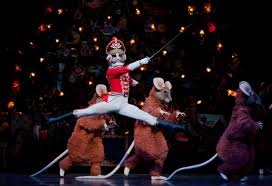
A few years ago, we went to see Tchaikovsky’s Nutcracker…
The holiday season at the Company is a spellbinding time, completely enveloped in the enchanting world of George Balanchine’s The Nutcracker™. This production is a grand spectacle of artistry and imagination, a beloved holiday tradition that brings together an extraordinary ensemble of talent. With all 90 dancers, 62 musicians, 32 stagehands, and two casts of 50 young students each from the School of American Ballet, the Company transforms each performance into a mesmerizing experience.
Audiences, including children and adults from New York City and beyond, flock to the David H. Koch Theater, drawn by the irresistible allure of Tschaikovsky’s iconic music, Balanchine’s masterful choreography, Karinska’s lavish costumes, and Rouben Ter-Arutunian’s enchanting sets. This production, a magical adaptation of the Alexandre Dumas pere version of E.T.A. Hoffmann’s tale, “The Nutcracker and the Mouse King,” is a full-scale theatrical marvel.
The production’s visual splendor is nothing short of breathtaking. The stage comes alive with elaborate elements and sophisticated lighting, creating an immersive world that captivates the imagination. One of the most stunning features is the one-ton Christmas tree that astoundingly grows from 12 feet to 40 feet, eliciting gasps of wonder from the audience at each performance. The whimsical Mother Ginger costume, weighing 85 pounds and spanning nine feet, and the delicate snowflakes that dance through the air add to the magic, making the ballet a visual feast.
However, it is Balanchine’s choreography that is the heart of the ballet, guiding the audience through a journey from the familiar to the fantastical. Act I sets the stage with its charming characters – the Stahlbaum children, Marie and Fritz, Herr Drosselmeier and his Nephew – and culminates in the dreamlike Snowflake Waltz. Act II is a complete immersion into the fantastical “Kingdom of the Sugarplum Fairy,” where the line between reality and fantasy beautifully blurs.
George Balanchine’s The Nutcracker™ stands as one of the most complex and captivating staged ballets in the Company’s repertoire. Its immense popularity is a testament to its ability to ignite the holiday spirit in everyone’s heart, making it an integral and unforgettable part of the holiday season.
Despite its humble beginnings, where the original production of Tchaikovsky’s The Nutcracker did not immediately capture the public’s adoration, a remarkable transformation occurred over time. Tchaikovsky, with his masterful touch, crafted a 20-minute suite from the ballet’s music that soared in popularity, showcasing his genius in a new light. This suite became the beacon that eventually led to the ballet’s widespread acclaim.Despite its humble beginnings, where the original production of Tchaikovsky’s The Nutcracker did not immediately capture the public’s adoration, a remarkable transformation occurred over time. Tchaikovsky, with his masterful touch, crafted a 20-minute suite from the ballet’s music that soared in popularity, showcasing his genius in a new light. This suite became the beacon that eventually led to the ballet’s widespread acclaim.
From the late 1960s onwards, The Nutcracker underwent a renaissance, becoming a cherished staple of the holiday season. Its popularity skyrocketed, especially in North America, where it became synonymous with Christmas festivities. Today, The Nutcracker is an essential part of countless ballet companies’ repertoires, celebrated for its enchanting story and exquisite choreography.
The ballet’s commercial success is astounding, with major American ballet companies attributing approximately 40 percent of their annual ticket revenues to performances of The Nutcracker. This statistic alone speaks volumes about the ballet’s enduring appeal and its significant role in the cultural landscape of ballet and Christmas traditions alike.
Tchaikovsky’s score for The Nutcracker, with its lush, evocative melodies and intricate compositions, has risen to become one of his most renowned works. The pieces from the suite, in particular, have captivated audiences worldwide with their beauty and complexity, securing The Nutcracker’s place as not just a seasonal favorite, but a timeless masterpiece of classical music.




